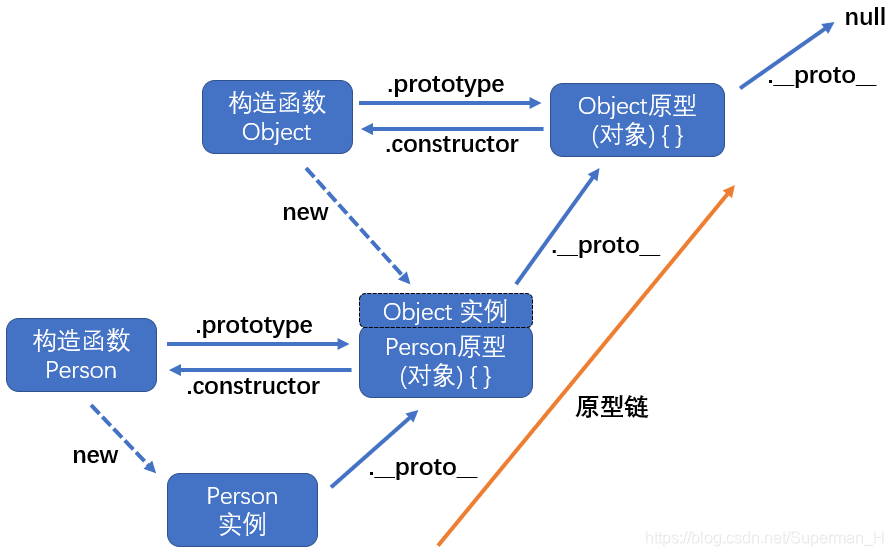原型链
构造函数的属性是各个实例自己的属性,原型(对象)的属性是所有实例共享的属性

- 构造函数的原型 (
prototype),就是它的实例的原型对象 (__proto__) Object.protptype是最顶层的原型(对象),其原型对象为null- 只有
Object.protptype没有原型对象(为null);除此之外的对象,都能通过.__proto__找到原型对象 - 一般构造函数的原型,是
Object的实例;构造函数的原型的原型对象,是Object.prototype
构造函数
- 引用类型:有内置的构造函数:
Object()、Array()、Function()、RegExp()、Date()… - 基本类型:① 有内置的包装类:
Number()、String()、Boolean();②null、undefined无包装类
原型链查找逻辑
访问实例的属性时,先查看该实例的属性;若没有,则查看其原型对象的属性;若还是没有,则查看其原型对象的原型对象的属性;以此类推… 直至找到 Object.prototype
- 所以,所有对象都能使用
Object.prototype的属性 ,eg:toString() - 如果我们给
Object.prototype添加属性,则所有的实例对象都能使用该属性 - 如果我们给实例重写了一些的同名属性,会覆盖其原型对象的属性,eg:
Number.toString()
判断对象的属性
① 对象可以通过打点,判断属性是否存在于原型链中
如果属性存在,则返回属性值;如果不存在,则返回 undefined;如果属性值为 undefined,也返回 undefined
var obj = {
a: 1
}
console.log(obj.a) // 1
console.log(obj.b) // undefined
obj.__proto__.b = 2
console.log(obj.b) // 2
② 可以通过 in 运算符,判断属性是否存在于原型链中
- 如果属性存在,则返回
true;否则返回false - 注意属性是 string 类型的,要用引号括住
var obj = {
a: 1
}
console.log("a" in obj); // true
console.log("b" in obj); // false
obj.__proto__ = {
b: 20
}
console.log("b" in obj); // true
- 我们还可以通过
in操作符,遍历原型链上的可枚举属性 - 可枚举属性是指原型链上,自己添加的属性。系统默认的属性(eg:constructor)是不可枚举的
for (var k in obj) {
console.log(k)
}
我们可以通过
hasOwnProperty(),判断属性是否在实例自己身上
hasOwnProperty()定义在Object.prototype对象上面,所以任意对象都可调用该方法- 如果实例存在指定属性,则返回
true;否则返回false(不考虑原型链)
var obj = {
a: 1
}
obj.__proto__.b = 4
console.log(obj.hasOwnProperty("a")); // true
console.log(obj.hasOwnProperty("b")); // false
配合 for in 使用,就可以遍历实例自己的属性啦
for (var k in obj) {
obj.hasOwnProperty(k) && console.log(k);
}
Object.defineProperty()
我们可以通过 Object.defineProperty() 方法,定义属性 / 修改属性的配置(eg:是否可枚举)
该方法接收 3 个参数:属性所在的对象、属性名、描述符对象
描述符对象有以下配置项:
configurable:是否可以重新配置;默认为trueenumerable:是否可以通过for in枚举;默认为falsewritable:属性值是否可修改;默认为falsevalue:默认属性值;默认为undefined
var obj = {} // 创建空对象
Object.defineProperty(obj, 'name', {
// 修改配置项
configurable: true,
enumerable: true,
writable: true,
value: 'superman'
})
console.log(obj) // {name: "superman"}
除了以上配置项外,
描述符对象还有两个方法:
get:获取属性值时,会被调用set:修改属性值时,会被调用
Object.defineProperties()
- 可通过该方法,同时对多个属性进行定义 / 修改其配置
var book = {}
Object.defineProperties(book, {
_year: { // 我们约定,带下划线的属性,为私有属性,不可直接访问
writable: true,
value: 2004
},
edition: {
writable: true,
value: 1
},
year: {
get: function () {
return this._year;
},
set: function (newValue) {
if (newValue > 2004) {
this._year = newValue;
this.edition += newValue - 2004;
}
}
}
})
console.log(book) // {_year: 2004, edition: 1}
book.year = 2010
console.log(book) // {_year: 2010, edition: 7}
Object.getOwnPropertyDescriptor()
- 用于获取属性的描述对象
- 第1个参数:
属性所属的对象;第2个参数:属性名 - 返回该属性的
描述符对象
Object.getOwnPropertyDescriptor(obj, 'name')
instanceof
- 验证对象是不是原型链上面的构造函数创建出来的实例
function Dog() {}
function Cat() {}
Cat.prototype = new Dog() // 继承
var a = new Cat() // 通过 cat 创建实例
console.log(a.constructor) // ? Dog() {}
console.log(a.__proto__) // Dog {}
console.log(a.__proto__.__proto__) // {constructor: ?}
console.log(a.__proto__.__proto__.__proto__) // {constructor: ?, __defineGetter__: ?, …}
console.log(a.__proto__.__proto__.__proto__.__proto__) // null
console.log(a instanceof Cat) // true
console.log(a instanceof Dog) // true
console.log(a instanceof Object) // true

验证数组
- 使用
typeof
var arr = []
console.log(typeof arr) // object
- 使用
instanceof
var arr = []
console.log(arr instanceof Array) // true
arr 不一定是 Array 的实例,也有可能是某继承了 Array 的构造函数的实例
- 使用 API(IE9 开始兼容)
var arr = []
console.log(Array.isArray(arr)) // true
检测数据类型的方法
使用 Object.prototype.toString.call()
Object.prototype.toString() // "[object Object]"
Object.prototype.toString.call({}); // "[object Object]"
Object.prototype.toString.call(function () {}); // "[object Function]"
Object.prototype.toString.call([]); // "[object Array]"
Object.prototype.toString.call(123); // "[object Number]"
Object.prototype.toString.call("123"); // "[object String]"
Object.prototype.toString.call(true); // "[object Boolean]"
Object.prototype.toString.call(undefined); // "[object Undefined]"
Object.prototype.toString.call(null); // "[object Null]"
必须通过 Object.prototype 调用 toString(),因为子类可能重写了该方法(eg:Number(1).toString() = 1)
继承
原型链继承
将父级的实例作为子类的原型
子类可以重写父类的方法。重写后,子类的方法会覆盖父类的方法。
function People(name) {
this.name = name // 设置 People 的实例的属性
}
// 设置 People 原型的属性,是 People 的所有实例共享的属性
People.prototype.sayHello = function () {
console.log("名字:" + this.name)
}
function Student(name, id) {
this.name = name // 设置 Student 的实例的属性
this.id = id
}
// 继承:Student 的原型 = People 的实例
Student.prototype = new People('大明') // 创建了父类实例,造成父类实例的属性数据冗余
// 设置 Student 的原型的属性,是 Student 的所有实例共享的属性
// 同时也是实例 '大明' 自己的属性,会覆盖 People 原型的属性
Student.prototype.sayHello = function () {
console.log("姓名:" + this.name, "学号:" + this.id)
}
var Hong = new Student("小红", 1001)
Hong.sayHello() // 姓名:小红 学号:1001
console.log(Hong.__proto__) // People {name: "大明", sayHello: ?}
Hong.__proto__.sayHello() // 姓名:大明 学号:undefined
console.log(Hong.__proto__.__proto__) // {sayHello: ?, constructor: ?}
Hong.__proto__.__proto__.sayHello() // 名字:undefined

构造函数继承
- 可以简单地认为是,复制父类实例的属性给子类
- 方法都在父类的构造函数中定义,只能继承父类实例的属性
- 继承不涉及父类的原型链,不能继承父类的原型链上的属性
- 每个子类都有父类实例的函数的副本,影响性能
function People(name) {
this.name = name
}
People.prototype.sayHello = function () {
alert("你好我是" + this.name)
}
function Student(name, id) {
// 继承:调用父类函数
People.call(this, name)
this.id = id
}
Student.prototype.study = function () {
console.log("好好学习,天天向上")
}
var hong = new Student("小红", 1001)
console.log(hong.name, hong.id)
hong.study()
// hong.sayHello() // 会报错

组合继承
就是原型链继承和构造函数继承组合在一起:
- 通过构造函数继承,继承父类的属性
- 通过原型链继承,继承父类的原型链的属性,以实现函数的复用
function People(name) {
this.name = name
}
People.prototype.sayHello = function () {
console.log("名字:" + this.name)
}
function Student(name, id) {
People.call(this, name) // 构造函数继承:通过调用父类函数,继承父类的属性
this.id = id
}
// 原型链继承:通过父类的实例继承父类的原型链上的属性
Student.prototype = new People('大明') // 这里创建的父类实例的属性数据冗余了
Student.prototype.study = function () {
console.log("好好学习,天天向上")
}
var hong = new Student("小红", 1001)
console.log(hong) // 小红 1001
hong.sayHello() // 名字:小红
- 如果不用
构造函数继承,sayHello输出的名字是大明
寄生组合继承
通过空的构造函数,得到没有属性的子类原型。这样,在进行原型链继承时,就可以避免父类的实例属性数据的冗余
function People(name) {
this.name = name
}
People.prototype.sayHello = function () {
console.log("你好我是" + this.name)
}
function Student(name, id) {
People.call(this, name) // 构造函数继承
this.id = id
}
// 核心语句
function Fn() {} // 定义空的构造函数,没有任何属性
Fn.prototype = People.prototype // 插入到父类的原型链中
Student.prototype = new Fn() // 原型链继承
Student.prototype.study = function () {
console.log("好好学习,天天向上")
}
var hong = new Student("小红", 1001)
hong.sayHello() // 你好我是小红

圣杯模式
就是将寄生组合继承封装成函数
function inherit(People, Student) {
function Fn() {} // 定义空父类
Fn.prototype = People.prototype // 插入原型链
Student.prototype = new Fn() // 继承
Student.prototype.constructor = Student // 完善原型链
Student.prototype.parent = People // 添加'父类'属性
}
inherit(People, Student)
